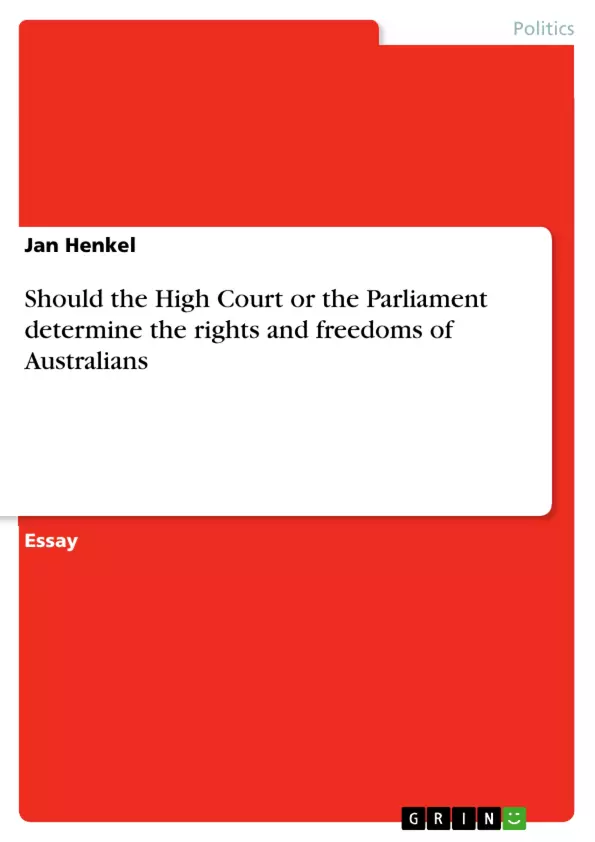It is known that in a democracy there are, in general, three different branches of the government: the legislative, the executive and the judicial branch. This essay explores the relative powers of the legislation and the judiciary in determining the freedoms and rights of modern days Australians. It specifically questions whether the High Court or the Parliament should determine the rights and freedoms of Australians.
If you examine modern day theories of democracy, you will discover that the legislative branch of government is traditionally responsible for making law and the judiciary for interpreting law. These two bodies, as they are respectively known in Australia, are the Parliament and the High Court. Between these two bodies, an intimate relationship exists that inevitably leads to interpretive and political conflicts, namely because it is “the judge it is who must decide what the Act means” (Gifford, p.39).
The main difficulty of this implicit conflict is a subjective determination concerning exactly where the power of the legislation, in our case the Parliament, ends and where the power of the judiciary, in our case the High Court, begins. In answering the main question of this essay, one must also address the relevant moral dimensions associated with this relationship. In adopting this methodology, I shall be able to decide which alternative is the better. Is it preferable if the High Court determines the rights and freedoms or should that be a task of the Parliament?
First of all I think it is necessary to emphasize the roles of the Parliament and the High Court in the Australian democracy. For that I would like to have a look into the Constitution of Australia and mention the traditional duties of the legislation and the judiciary in the separation of powers. After that I am going to discuss which freedoms and liberties should be protected in the Australian democracy. Are there pre-existing implied rights that are not mentioned directly in the Constitution and how can those rights be protected? Furthermore, I want to discuss if it is possible to protect those rights despite the fact that they are not mentioned directly in the Constitution. I also want to analyze the arguments for and against judicial activism, as well the issues relating to excessive judicial authority.
Inhaltsverzeichnis (Table of Contents)
- Introduction
- Main part
- The Constitution of Australia
- Jurisdiction of the High Court
- The Power of the Parliament and the High Court
- Human Rights in Australia
Zielsetzung und Themenschwerpunkte (Objectives and Key Themes)
This essay explores the relative powers of the legislature and the judiciary in determining the freedoms and rights of Australians. Specifically, it examines whether the High Court or the Parliament should be responsible for defining these fundamental rights. The essay aims to analyze the conflict between legislative power and judicial interpretation, particularly in the absence of a codified bill of rights in the Australian Constitution.
- The roles and responsibilities of the Parliament and the High Court in the Australian democracy.
- The nature and scope of implied rights in the Australian Constitution.
- The potential limitations on parliamentary law-making imposed by judicial interpretation of implied rights.
- The arguments for and against judicial activism in Australia.
- The protection of human rights in Australia, including the role of international treaties and the High Court's interpretation.
Zusammenfassung der Kapitel (Chapter Summaries)
- Introduction: This section introduces the essay's central question: whether the High Court or the Parliament should determine the rights and freedoms of Australians. It highlights the inherent tension between legislative and judicial powers in defining rights and freedoms, particularly in the context of a democracy.
- Main part:
- The Constitution of Australia: This section examines the Australian Constitution, focusing on the powers granted to the Parliament and the High Court. It explores the roles of these institutions in the separation of powers and their respective responsibilities in lawmaking and interpretation.
- Jurisdiction of the High Court: This section delves into the High Court's jurisdiction, drawing from the Constitution's description of its role in interpreting laws. The section explores the practical challenges in distinguishing between lawmaking and interpretation, particularly in light of the judiciary's potential influence on law-making through its interpretations.
- The Power of the Parliament and the High Court: This section analyzes the power of the Parliament and the High Court in defining rights and freedoms, focusing on the absence of a bill of rights in the Australian Constitution. The section explores the potential for conflict between these two bodies as they seek to maximize their own political power.
- Human Rights in Australia: This section examines the protection of human rights in Australia, considering both the presence of international treaties and the High Court's role in recognizing implied rights. The section explores the potential limitations on parliamentary law-making imposed by the judiciary's interpretation of implied rights and the arguments for and against judicial activism.
Schlüsselwörter (Keywords)
The main keywords and focus topics of the essay include: Australian democracy, separation of powers, High Court, Parliament, rights and freedoms, implied rights, judicial activism, bill of rights, international treaties, human rights, legislative power, judicial interpretation.
- Quote paper
- Diplom Volkswirt; M.A. Jan Henkel (Author), 2004, Should the High Court or the Parliament determine the rights and freedoms of Australians, Munich, GRIN Verlag, https://www.hausarbeiten.de/document/54931


